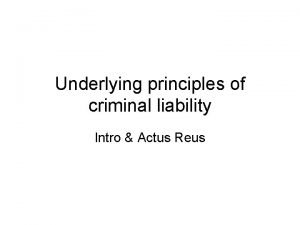Mens Rea 2 Coincidence of Mens Rea and






- Slides: 6

Mens Rea 2

Coincidence of Mens Rea and Actus Reus • General principle – AR and MR must occur at the same time – this is called the contemporaneity rule • But, the courts have modified this rule so that a series of linked acts or omissions can be treated as a single continuing event

Coincidence of Mens Rea and Actus Reus – Continuing Acts • Fagan v Metropolitan Police Commissioner – D accidently stopped his car on a policeman’s foot. Policeman asked him to remove the car from his food, D replied “F*** off you can wait”. D guilty of causing injury as leaving the car on the foot seen as a continuing act – even though he didn’t have MR for the act when he stopped the car on the foot, he did form the MR when he refused to move it and the act of placing the car on the foot remained

Coincidence of Mens Rea and Actus Reus – series of connected events • Thabo Meli – D hit V over the head intending to kill him. D believed V was dead and threw V over a cliff to make it look like an accident. V later died of exposure – court held MR continued throughout • Church – D had gone to his van with a woman for sexual purposes. She mocked his impotence and he attacked her, knocking her out. D panicked, believing V was dead and threw her unconscious body in the river, where she drowned. D argued that all he had done wrong was to dispose of or conceal a dead body, and MR for the attack on the woman ended when he thought her unconscious body was dead. Court held MR continued even after he thought she was dead, so included her drowning.

Transferred Malice • Where D’s MR is transferred from the intended V to actual V • Mitchell – D became involved in an argument while queuing at the post office. He pushed an elderly man, causing him to fall accidentally onto an elderly woman, who died from her injuries. Court held although there was no direct contact between D and V, she was injured as a direct result of her actions, and MR was transferred to V • Latimer – D aimed to hit someone with his belt but missed and hit a bystander. MR transferred to V from his intended V as the offence was of the same type as he originally intended • If the offence on the new V is different to that which was intended, there is no MR • Pembilton – D threw a stone at his intended V but missed and broke a window. MR of intending to cause harm to V was not transferred to the window.

Steps when applying Mens Rea 1. Is there direct intent - the decision to bring about the criminal consequence 2. If not, is there indirect intent? : – Was the consequence a virtually certain result of the act? – Did D know that it was virtually certain? (subjective) 3. If not, is there subjective recklessness? – Does D foresee that the particular kind of harm might be done? – Has D gone on to take the risk anyway? 4. Is there coincidence of AR and MR? – Consider whethere is a series of continuing acts 5. Is there any issue of transferred malice?









